
One of the key market trends we have noticed is the reduced range of weights available. Gone are the days where you could choose light medium or heavy like a Cricket bat, as buying patterns have massively favoured the light & superlight, manufacturers have reduced the choice. In general sticks will weigh from 540-550 grams for light & 520-535 grams. As materials such as resins, graphene, Carbon have become more prominent sticks have naturally become lighter & stronger than traditional Kevlar & fibreglass. The benefits… faster hand speeds, drawbacks… less deadweight for block tackles, hits & slaps.
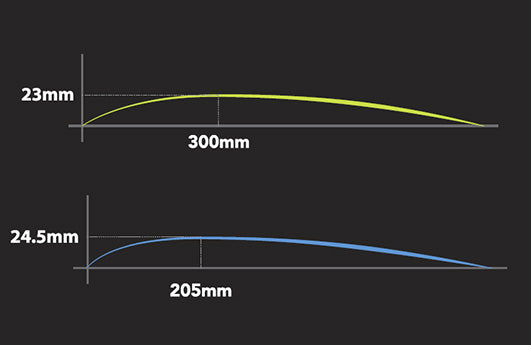
The balance point is usually measured from the head of the stick to the point & which the stick balances on a fulcrum. The closer the balance point is to the head the lower it is & vice versa. With sticks becoming naturally lighter, balance points have become more important to match player styles in the absence of choice in weights. It is also interesting to remember that balance points are individual to each stick despite the modern manufacturing process.
Low balance points mean the stick will feel head or bottom heavy. This would be ideal for players who rely on their block tackles, hitting & slapping skills who may have been used to medium or heavy weight sticks. High balance points mean the stick will feel lighter as most of the weight is closer to the hands & wrists. This would be better suited to players who rely more on dribble, push pass & perform 3D or aerial skills.
If you have a stick you really like & the only thing that you want to change is the balance point then never fear, by adding extra weight in the handle, such as an extra grip or two or weighted tape like golfers raises the balance point. If you wanted to lower the balance point you could use weighted tape of the back of the shaft or a couple of layers of cloth tape to add some extra weight nearer the head. Just remember the stick must got through the stick gauge.
Bows
It's been over a decade since the FIH rules changed to allow a maximum bow of 25mm, yet the majority of bows on the market come up to 24mm. Currently the market offers 3 bow shapes all which have their own performance characteristics.
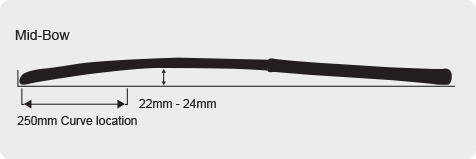
A traditional bow which will approximately reach it’s peak at 250mm from the head with a max bow of 22mm - 24mm depending on manufacturer. This allows for a longer distance for the bow to be expressed in the profile, keeping the head in line with the hands making it ideal for players to perform all the basic skills to a high level & have some assistance for lifting & drag-flicking.
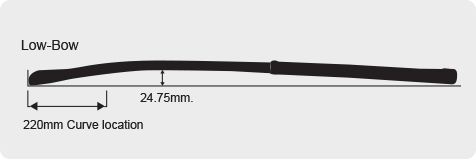
A modern day bow which will approximately reach it’s peak at 220mm from the head with a max bow of 24.75mm. The slightly shorter distance for the bow to be expressed creates a greater slingshot effect ideal for powerful drag-flicks. The head sits slightly in front of the hands making it easier to lift the ball, perform 3D skills & aerials without losing your hit or slapping ability. A greater degree of skill is required to execute the basic skills to the same level as with a midbow.
Kevlar/Aramid: A fibrous, flexible material used to maximise the strength of a hockey stick, which is seen as a step up from fibreglass and is used in bullet-proof vests.
Carbon Fibre: By no means the cheapest of materials, carbon fibre is composed of light strands of carbon woven into sheets or strips. Greater power was permitted in a hockey stick through the application of carbon fibre, as it vastly enhanced the stiffness – the more carbon fibre the stiffer the stick. It is also a very strong material but its poor impact protection means that breakages are frequent, which is why carbon fibre is often married with Kevlar/Aramid to offset its brittleness.
TOP TIP: The greater amount of Carbon Fibre the stiffer and more expensive the hockey stick is to manufacture – hence it is of a higher standard. The greater amount of fibreglass used the more flexible and affordable the stick is.
DECISION TIME: A WOODEN OR A COMPOSITE HOCKEY STICK?
Wooden hockey sticks
Below are some of the pros and cons of using wooden hockey sticks and composite hockey sticks. What will you opt for?
Price: Wood is a cheaper material compared to the use of a range of composite materials, so wooden hockey sticks offer greater affordability. The high cost of composite materials and the sophisticated production process means that a composite hockey stick will be greater in price compared to a wooden hockey stick of a similar specification.
Feel: Many international hockey players prefer wooden sticks as it offer a softer feel on the ball. Composite hockey sticks tend to have a less refined feel for the ball, but manufacturers are working at ways to reduce this deficit in touch.
Consistency: As wood is hand-made and wooden sticks are only as good as the wood that they are sculpted from, inconsistencies exist in quality, moisture levels and density. Specifications of composite hockey sticks are more consistent in weight, stiffness and power.
Durability: Wood is prone to wear and tear, especially on sand-based surfaces, while moisture can be drawn into the stick over time which may lead to breakages. With a high resin composition, composite hockey sticks naturally bond intimately, boosting durability and consistency in feel.
Power: Generally, wooden hockey sticks are not quite as powerful due to a smaller hitting zone. Composite sticks are renowned for a greater power-to-weight ratio, while the heads of composite sticks are manufactured to create a maximised sweet spot.
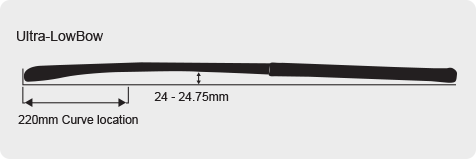
Drag-flicking & 3D skills have filtered down very quickly from the pro’s & have become a secret weapon across the game. The ULB will approximately reach its peak at 200mm from the head of the stick with the max bow being 24 - 24.75mm. Shorter distance to express the bow creates the ultimate slingshot effect & often will be combined with a concave shaft to make a specialised drag-flick stick. Again, the head will sit in front of the hands requiring a greater skill level to maintain the execution of your hits & slaps.
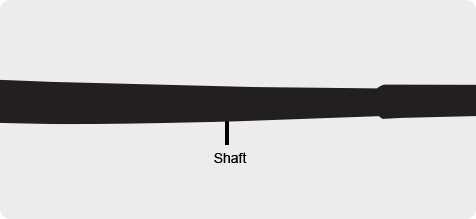
The market has experienced various changes to the back or spine of the shafts using geometry to improve power & reduce weight however the main hitting areas have traditionally stayed the same until recently. New to the market is the change in shaft shapes more so in the face & backhand zones.
Concaving: Concaving is now being used mainly in the face of the shaft in the main hitting areas of the shaft. This concave effect increases energy transfer from stick to the ball during a drag-flick to give a higher degree of accuracy & power. Some concaving also goes into the head ideal for dribbling & 3D skills at the expense of hitting power & control.
Wide Backhand Zone: In some of the most recent models manufactures have recognised the market for extra control when performing reverse stick hits or tomahawks. As a result, the shaft shapes have changed in this key area making them wider & flatter nearer the head to give a greater surface area for more consistent execution of the tomahawk & shave tackles.
Head Shapes
With more research being poured into improve performance what was once a simple choice between Maxi, Midi & hook has now become slightly more interesting.
Maxi: The most popular head type accounting for 85% of the market. Your all-rounder head shape combining deep sweet-spot for hitting, hook shape for dribbling, reverse carries & drag-flicking. If your stick does not specify the head shape it is most likely going to be a Maxi.
Apex: This has all the benefits of the Maxi but has an almost square toe giving extra surface area for reverse carrying, reverse tackling, dribbling, 3D skills & perfect stopping angle at short corners.
Midi: A shorter hook compared to the Maxi which makes the stick slightly more mobile.
Hook: Possessing a longer hook than the maxi, it improves upright stopping potential, greater control of dribbling skills & very good for pulling out at short corners.
3D/cutaway head: Part of the drag-flick revolution these head shapes have a similar hook to the maxi but has a much thinner heel area making it easier to get under the ball ideal for aerials, 3D skills & drag-flicks. Due to the reduced mass of the head, you can expect a smaller sweet spot when hitting.

